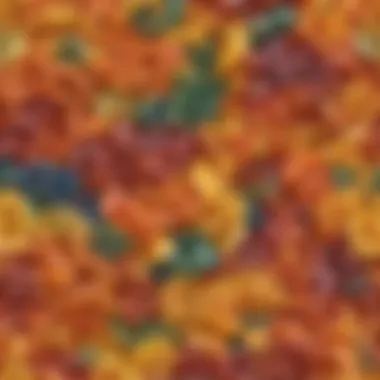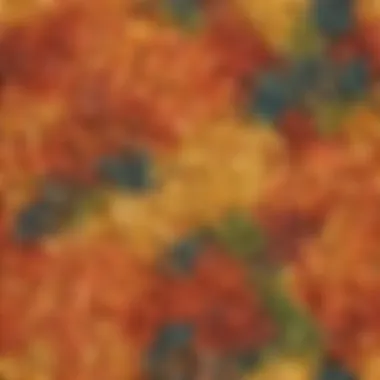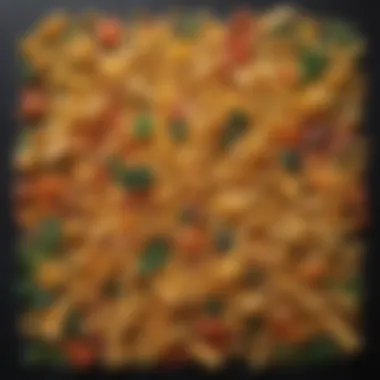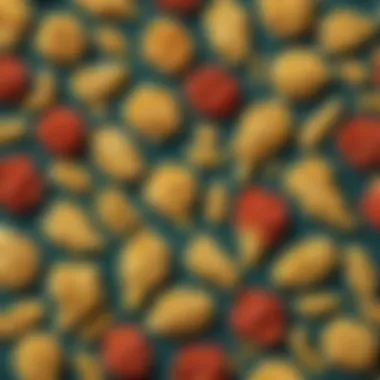Unleash Creativity: The Art of Painting Pasta for Kids


Fun Activities Ideas
When it comes to engaging children in a fun and educational activity, painting pasta stands out as a creative and exciting endeavor. With a few simple tools and a dash of imagination, kids can transform plain pasta into colorful masterpieces, unleashing their artistic skills in a unique way. This activity falls under the realm of arts and crafts, providing an opportunity for children to explore their creativity while having a blast.
Arts and Crafts
Painting pasta is not just about creating visual delights; it also involves a hands-on approach that encourages sensory exploration and fine motor skill development. As children select their pasta pieces, dab on vibrant colors, and watch their creations come to life, they are engaging in a tactile experience that enhances their cognitive abilities. This activity bridges the gap between artistic expression and sensorimotor development, making it a well-rounded arts and crafts activity for kids.
Parenting Tips and Resources
To make the most of the art of painting pasta, parents can incorporate various tips to enrich the experience for their children. By providing a playful learning environment that nurtures creativity and experimentation, parents can inspire their kids to push the boundaries of artistic expression. Balancing screen time with hands-on activities like painting pasta helps in reducing reliance on digital devices and fosters strong family bonds through collaborative art sessions at home.
Fun Facts and Trivia
Delving into the world of painting pasta can also spark curiosity in children about different cultures and traditions. Parents can take this opportunity to share fun facts about pasta shapes, origins, and its significance in various cuisines worldwide. This hands-on activity can serve as a gateway to exploring the historical and cultural aspects of food while igniting a sense of wonder and discovery in young minds.
Introduction
Painting pasta is more than just a creative activity; it's a gateway to unlocking a world of artistic expression and imagination for children of all ages. In this article, we will delve into the captivating art of transforming ordinary pasta into colorful masterpieces, offering a unique and engaging platform for young artists to explore their creativity. By painting pasta, kids can not only hone their fine motor skills but also learn about colors, textures, and different painting techniques in a fun and interactive way.
We will unravel the intricacies of pasta painting, from understanding its origins to discussing the numerous benefits it offers. Through this guide, parents, teachers, and guardians can gain valuable insights into how this activity promotes cognitive development and fosters a sense of accomplishment in children. Moreover, we will highlight the essential materials needed for pasta painting and provide crucial safety precautions to ensure a secure and enjoyable painting experience for kids.


In a world where digital distractions abound, engaging in hands-on creative endeavors like pasta painting can stimulate a child's senses, encourage mindfulness, and offer an alternative to screen time. By immersing themselves in the world of pasta painting, young artists can unleash their imagination, boost their confidence, and create tangible works of art that showcase their unique artistic flair. Join us on this artistic journey as we explore the art of painting pasta and witness the wonders it can unveil in the realm of children's creativity.
Understanding the Art of Painting Pasta
The topic of understanding the art of painting pasta holds significant weight in this article as it serves as the foundation for engaging in a unique and creative activity. By comprehending the various techniques, tools, and intricacies involved in pasta painting, readers can unlock their creative potential and experience the joy of transforming plain pasta into colorful artworks. This section will delve into specific elements such as the historical significance of pasta painting, the educational benefits it offers to children, and essential considerations to keep in mind while engaging in this creative process.
The Origins of Pasta Painting
Delving into the origins of pasta painting unveils a rich history dating back to ancient civilizations where pasta was not just a culinary delight but also a canvas for artistic expression. From traditional Italian pasta art to modern interpretations across the globe, the practice of painting pasta has evolved into a cherished form of creative exploration. Understanding the roots of pasta painting provides insights into cultural influences, artistic traditions, and the evolution of this unique art form.
Benefits of Painting Pasta
Painting pasta goes beyond a mere recreational activity; it nurtures essential skills in children such as hand-eye coordination, creativity, and patience. By engaging in pasta painting, kids can enhance their cognitive abilities, boost self-esteem through artistic achievements, and develop a deeper appreciation for art. Additionally, this hands-on experience fosters a sense of accomplishment and allows children to express themselves freely through colors and designs.
Materials Needed
To embark on a pasta painting journey, one must gather a variety of materials ranging from different types of pasta shapes to non-toxic paints, brushes, and protective gear. The choice of materials directly influences the outcome of the artwork, so selecting high-quality supplies is crucial for a successful painting session. This section will detail the specific materials required, their purposes, and tips for selecting the best tools to unleash creativity and ensure a seamless art-making process.
Safety Precautions
While pasta painting is a fun and engaging activity, it is essential to prioritize safety measures to prevent any accidents or mishaps. From using non-toxic paints to ensuring adequate ventilation in the painting area, safety precautions play a vital role in creating a secure environment for children to explore their artistic talents. This section will outline safety guidelines, precautionary steps, and best practices to guarantee a safe and enjoyable pasta painting experience for young artists.
Getting Started: Preparing Your Workspace


When diving into the art of painting pasta, the initial step of preparing your workspace is crucial to ensure a smooth and enjoyable creative process. Organizing your workspace effectively sets the tone for a successful and productive painting session. By creating a designated area for your artistic endeavors, you are not only enhancing the aesthetics of your environment but also optimizing functionality.
The importance of this preparation lies in its ability to facilitate a focused and comfortable setting. Having a dedicated space for painting pasta allows you to immerse yourself fully in the creative process without distractions. This separation helps stimulate creativity and concentration, enabling you to unleash your artistic potential to the fullest.
Moreover, preparing your workspace plays a vital role in fostering a sense of organization and neatness. By setting up a specific area for painting pasta, you can streamline the process of gathering and accessing your supplies efficiently. This structured approach saves time and energy, allowing you to delve into the artistic experience without interruptions or delays.
In addition to improving workflow and functionality, organizing your workspace promotes a sense of mindfulness and intentionality in your artistic practice. By intentionally creating a space dedicated to painting pasta, you signal to your mind the importance of this creative activity. This subconscious cue helps in establishing a mental framework geared towards artistic inspiration and expression.
Overall, preparing your workspace for painting pasta is not just about physical arrangement; it is about setting the stage for a transformative and enriching creative journey. From enhancing focus and reducing distractions to promoting a structured and mindful approach, the act of getting started in a well-prepared workspace sets the tone for a rewarding artistic experience.
Exploring Different Painting Techniques
In the realm of pasta painting, exploring different painting techniques holds significant importance as it adds depth and variety to the artistic process. By incorporating various techniques, individuals can unleash their creativity and produce visually stunning pieces. Each technique offers distinct benefits and considerations that contribute to the overall artistry of the pasta paintings.
Brush Painting
Brush painting is a fundamental technique in pasta painting that allows artists to achieve precise and detailed strokes. It involves using different types of brushes to apply paint to the pasta surface, enabling intricate designs and patterns to emerge. The key to successful brush painting lies in selecting the appropriate brush size that suits the desired effect. Furthermore, experimenting with different brush strokes can create diverse textures and visual appeal in the artwork.
Sponge Painting
Sponge painting is a versatile technique that adds a unique textured finish to pasta paintings. By dabbing a sponge or sponge brush dipped in paint onto the pasta, artists can create soft and blended color effects. This technique is popular for producing gradients and enhancing the tactile quality of the artwork. Sponge painting encourages a more abstract and free-flowing style, making it suitable for artists looking to explore unconventional painting methods.


Drip Painting
Drip painting introduces an element of spontaneity and movement to pasta artworks. By dripping or pouring paint onto the pasta canvas, artists can achieve fluid and organic patterns that have an ethereal quality. This technique often involves tilting the surface to control the direction of the drips, resulting in dynamic compositions. Drip painting allows for experimentation with color intensity and flow, offering endless possibilities for creative expression.
Texture Painting
Texture painting focuses on creating tactile surfaces on pasta pieces through various means. Artists can incorporate materials like sand, flour, or even small pasta shapes to add dimension and interest to their artwork. By layering different textures and manipulati
Creating Artistic Masterpieces with Pasta
In this section, we will delve into the significance and key elements of creating artistic masterpieces with pasta within the context of this article. Painting on pasta not only enhances creativity but also serves as a hands-on artistic activity that fosters fine motor skills and imaginative thinking in children. Through this unique medium, young artists can explore different textures and shapes, transforming simple pasta into marvelous works of art.
Ideas for Pasta Painting Projects
When embarking on pasta painting projects, the possibilities are endless. Children can experiment with various themes such as nature, animals, or abstract patterns. Encourage them to leverage different pasta shapes like penne, fusilli, or spaghetti to create unique textures and designs. Incorporating multiple colors and techniques like layering, blending, or stenciling can add depth and visual interest to their creations.
Tips for Achieving Stunning Results
To achieve stunning results in pasta painting, it is essential to provide children with the right tools and guidance. Start by using non-toxic paints that are safe for children and easy to wash off. Teach them to mix colors to create new shades and encourage precision and creativity in their brush strokes. Additionally, explore unconventional methods like using q-tips, sponges, or even fingers to add different dimensions to their artwork.
Preserving and Displaying Your Artwork
Once the artistic masterpieces are complete, it is crucial to preserve and showcase them appropriately. Allow the artwork to dry completely before handling or displaying it. Consider framing the pieces or mounting them on a bulletin board to exhibit them proudly. By discussing the inspiration behind each creation, children can develop confidence in showcasing their pasta paintings to family and friends.
Conclusion
By highlighting the key points discussed, it becomes evident that painting pasta is more than just a recreational activity - it serves as a platform for young minds to explore their artistic potential, learn new techniques, and develop a deeper appreciation for the arts. The relevance of this topic lies in its ability to seamlessly blend fun and education, offering children a meaningful way to engage with art while enhancing their cognitive and motor skills.
Considering the specific elements presented in this article, painting pasta emerges as a holistic activity that encourages experimentation, boosts confidence, and nurtures a sense of creativity in children. Moreover, the benefits extend beyond just the final artwork; they encompass the process itself, which fosters patience, attention to detail, and an outlet for self-expression. As parents, teachers, or guardians, embracing the concept of painting pasta can pave the way for meaningful bonding opportunities with children, creating lasting memories and inspiring a lifelong love for creativity.



